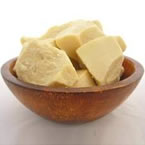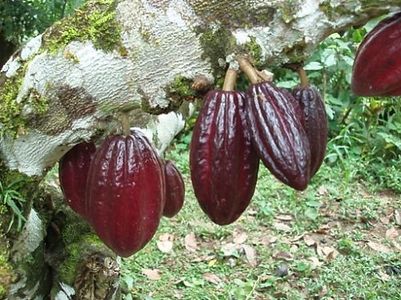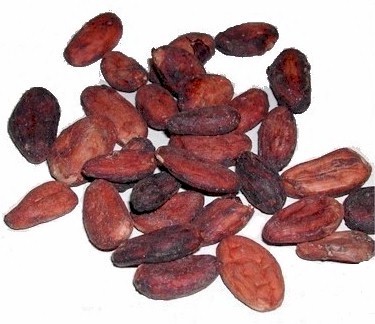 ...........
........... ...........
...........
 ...........
........... ...........
...........
|
Cocoa butter is the natural fat from cacao beans. The extracted fat, light yellowish in color, is edible, with a slight chocolaty flavor and scent. It also goes by the name of theobroma oil. For some reason the British called Cacao beans Cocoa beans. The reason seems to have gotten lost in history.
Health Benefits of Cocoa Butter
Cocoa butter has many health benefits internally and externally. A natural fat that is extracted from the cacao bean, cocoa butter is used in cosmetics, topical lotions and creams as well as in the making of high quality chocolate. Cocoa butter has a large amount of CMP (Cocoa Mass Polyphenol) which is a chemical that helps to prevent heart disease as well as treat the symptoms of arthritis and dermatitis. Cocoa butter is used as a moisturizer for dry skin and to prevent stretch marks. Cocoa butter is also effective against eczema and dermatitis. High magnesium levels in high quality chocolate containing cocoa butter can prevent the progesterone drop that leads to PMS. Cocoa butter can lower LDL (bad cholesterol) levels. Also, cocoa butter contains oleic acid, an unsaturated fat that raises HDL (good cholesterol) levels. Cocoa butter contains a chemical called Pentamer which can help protect against cancer. Cocoa butter is high in antioxidants in the form of flavonoids that protect the heart and arteries from damage by free radicals. Cocoa butter in chocolate raises endorphin and serotonin levels in the brain which can improve your mood.
Functions in Skin Care
Benefits
Presence of antioxidants and vitamins
Other Uses of Cocoa Butter
Health Benefits of Cacao Beans
Pronounced like: ka-cow. It seems the Brittish couldn't pronounce the word cacao, so they called it cocoa instead. Many people consider eating chocolate a "guilty pleasure." But the reputation of chocolate as a junk food should more accurately be attributed to the harmful effects of commercial processing and refining techniques, and the other ingredients commonly added, most notably white sugar. All chocolate is made from the cacao bean, and cacao beans in their natural, unprocessed, unadulterated state are rich in nutrients and beneficial to health. Why Unprocessed Chocolate is Good for YouAntioxidants: Cacao has more antioxidant flavonoids than any food tested so far, including blueberries, red wine, and black and green teas. In fact, it has up to four times the quantity of antioxidants found in green tea. While blueberries contain 32 antioxidants, and wild blueberries contain 61 ..cacao beans contain an unbelievable 621 anti-oxidants!!! Health benefits of these antioxidants include:
Neurotransmitters: By increasing the levels of specific neurotransmitters in our brains, cacao promotes positive outlook, facilitates rejuvenation and simply helps us feel good.
Essential Minerals: Cacao beans are rich in a number of essential minerals, including magnesium, sulfur, calcium, iron, zinc, copper, potassium and manganese.
Essential fats: There is a misperception that chocolate is fattening. In truth, the fats in cocoa butter are healthy fats. Cacao contains oleic acid, a heart-healthy monounsaturated fat, also found in olive oil, that may raise good cholesterol. Also, substances found in cacao are known to help reduce appetite. Important note: To fully benefit from chocolate’s wide array of nutrients, eat chocolate that is as close to its natural state as possible. Whole cacao beans are best. You lose many of the health benefits when you eat commercially produced chocolate. Cacao: Its History and Use From the Time of the Aztecs to TodayThe cacao tree has been cultivated in Mexico and Central and South America for thousands of years, and it has been so highly valued that some Native peoples once used its seed, or bean, as currency. The Aztecs believed cacao to be of divine origin, and both they and the Mayans used the roasted bean in the famous beverage Chocolatl, together with vanilla and other flavorings. In the early 16th century, Columbus brought sacks of cacao back to Europe, but he did not realize its economic value. Then, in 1519, Cortez brought cacao back to Spain, and it was soon made into a luxury drink for the upper classes. By the 17th and early 18th centuries, chocolate was considered a cure for many illnesses, as well as a catalyst for provoking passion, although it was still too expensive for the general populace. Finally, in the 18th century, chocolate houses were established in London, making chocolate available to a broader spectrum of society, and their popularity quickly surpassed that of the coffee houses. Today cacao is planted on over 43,000 square miles worldwide. Forty percent of production is from Cote d’Ivoire, while Ghana and Indonesia produce about 15% each, and Brazil, Nigeria, and Cameroon provide smaller quantities. How Cacao is HarvestedCacao beans are harvested today in much the same way as they were by the Aztecs. After the pods ripen, which takes 5 to 6 months, they are removed from the tree and carefully cut open with a machete, and the cacao beans are extracted. After harvesting, the beans are placed on banana leaves in large wooden boxes and left to ferment for several days. During fermentation, complex chemical changes take place. The bitterness of the bean is reduced and the rich chocolate flavor begins to develop. The beans are dried after fermentation, and during this drying process, the brown color develops and further flavor development occurs. The Different Varieties of CacaoThere are three main cultivar groups of cacao beans grown today:
For most people 1 or 2 cacao beans a day is ample. Cacao beans are seeds and like most seeds are nutrient rich since they contain the necessary nutrients for new life. All seeds and nuts should be eaten sparingly for this reason.
Some Suppliers of Cocoa Butter and Cacao Beans
100% Pure Cocoa Butter (Bulk Apothecary) Cocoa Butter - Bulk (JEDWARDS International, Inc.) ........ - - - - - - - - - - - - - - - - - - - - - - - - - - Organic Cacao Beans - Raw (Nuts.com) Cacao Nibs, Roasted (The Spice House) Cacao Beans - Raw (Live Superfoods) Organic Cacao Beans 16 oz - Tribest SJ003B (Newegg) Organic Cacao Beans 16 oz - Tribest SJ003B (Greater Medical) Organic Cacao Beans 16 oz - Tribest SJ003B (Pricefalls) Please note that the contents of this page are for information purposes only. It is not to be in any way, shape or form construed as providing, or attempting to provide medical advice.
|